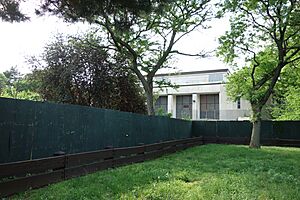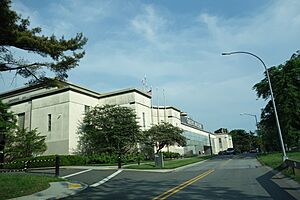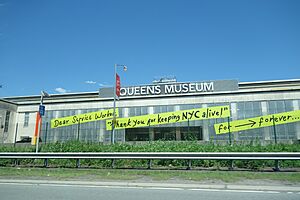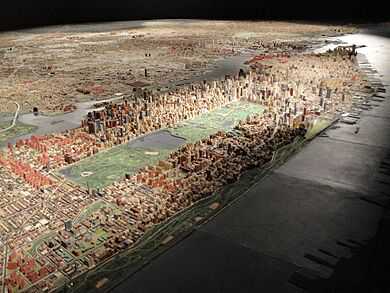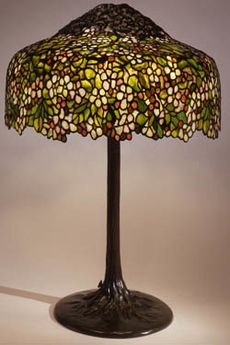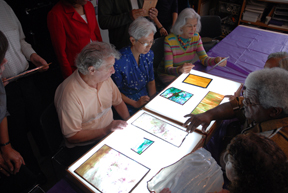Queens Museum facts for kids
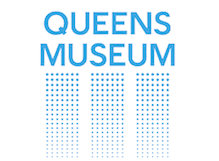 |
|
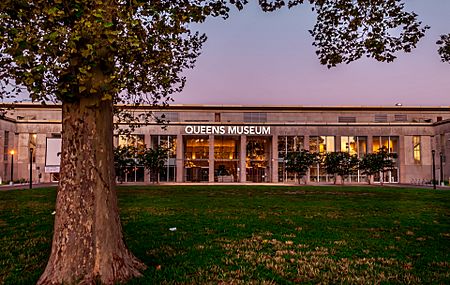 |
|
| Established | 1972 |
|---|---|
| Location | Flushing Meadows–Corona Park, Queens, New York 11368 |
| Type | Art museum |
| Public transit access |
|
The Queens Museum is an exciting art museum and learning center located in Flushing Meadows–Corona Park in Queens, New York City. It opened in 1972 and is famous for its amazing Panorama of the City of New York, which is a giant model of all five boroughs of New York City. This huge model was first built for the 1964 New York World's Fair. The museum also has a large collection of cool items from both the 1939 and 1964 World's Fairs, and you can see some of them on display. As of 2018, the museum's director is Sally Tallant.
The building where the museum is located has a long and interesting history! It was originally built for the 1939 New York World's Fair as the New York City Pavilion. After that, it was used as an ice-skating and roller-skating rink for many years. From 1946 to 1951, it even hosted the United Nations General Assembly! The building was used again as the New York City Pavilion for the 1964 World's Fair and was saved after the fair ended. The Queens Museum officially opened in the northern part of the building in November 1972. The museum has been updated and expanded several times over the years, making it bigger and better for visitors.
Contents
History of the Museum Building
From World's Fair to Museum
The 1939 World's Fair Building
The Queens Museum is inside the New York City Pavilion, which was designed by architect Aymar Embury II for the 1939 World's Fair. This fair was announced in 1935, and plans for a building to represent New York City were made. The building was meant to be a permanent structure, unlike most other buildings at the fair which were taken down. It cost about $1.6 million to build.
Inside the pavilion, there were cool displays, murals, and models that showed how the city government worked. You could learn about the WNYC radio station, the city's courts, and the subway system. There were also stage shows and even a voting demonstration! The fair opened on April 30, 1939, and ran for two seasons.
United Nations and Skating Rink Years
After the 1939 World's Fair closed, the New York City Building was one of only a few structures that stayed. In 1940, it was turned into an ice-skating and roller-skating rink. These rinks were very popular, with over a million visitors in their first five years!
In 1946, the United Nations needed a place to meet while they planned their permanent headquarters. So, the New York City Pavilion was chosen to host the United Nations General Assembly. The building was renovated for these important meetings. Many big decisions happened here, like the creation of UNICEF and the plan for Israel. The UN stayed in the building until 1951.
After the UN moved out, the building was changed back into a skating rink. It reopened in 1952 and continued to be a popular spot for skaters.
The 1964 World's Fair
The Flushing Meadows park was chosen again for the 1964 New York World's Fair. The New York City Building was reused as the city's exhibition space. A huge project began to build the Panorama of the City of New York, a giant scale model of the city, inside the building. This amazing model cost $600,000 and took two years to build!
The building was officially reopened for the fair on April 25, 1964. Besides the Panorama, there were ice-skating shows and even simulated helicopter rides over the city model. The New York City Building was one of the few structures kept after the 1964 fair ended in 1965.
The Museum's Beginning and Growth
Creating the Museum
In 1971, city officials decided to turn part of the New York City Pavilion into Queens's first art museum. The Queens County Art and Cultural Center officially opened on November 12, 1972. It was seen as a big step for the arts in Queens.
When it first opened, the museum had about 50,000 square feet of space. A big part of this was taken up by the Panorama. This meant there wasn't a lot of room for other art displays. The museum was very popular with school groups, but many couldn't visit because of the limited space. The ice-skating rink still used the southern half of the building.
Growing Through the Years
The museum changed its name to the Queens Museum in 1973. Over the years, the museum worked to become more well-known and to get new art. In 1979, the Queens Museum's Community Gallery opened, giving local artists a place to show their work.
Through the 1980s, the museum continued to grow. By 1982, it used almost half of the building. In 1986, a sculpture hall opened with many casts of famous sculptures. By the end of the 1980s, the museum had 100,000 visitors each year, much more than when it first opened!
Updates in the 1990s
In the early 1990s, the city gave the museum $13.5 million for a big renovation. The museum's name was also changed to "Queens Museum of Art." Architect Rafael Viñoly redesigned the building, adding new galleries, classrooms, and offices. A new entrance was built facing the Unisphere, and an auditorium was added. The Panorama was also updated during this time.
The renovation finished in 1994, doubling the gallery space. This allowed the museum to show more art and host exhibits that celebrated Queens's many different cultures. By the late 1990s, there were talks about moving the ice rink to a new location so the museum could expand even more.
The 21st Century Museum
Big Changes in the 2000s and 2010s
In the early 2000s, the museum planned a major expansion. The idea was to move the ice skating rink and add more exhibition space. After some changes to the plans, Grimshaw Architects designed a new look for the museum.
In 2009, the museum began a big expansion project. The old ice skating rink was moved to a new facility in the park, and the museum took over that space. This project cost $69 million and added 50,000 square feet of new space for exhibits, education, and offices. The expanded museum reopened in November 2013, and its name was shortened back to Queens Museum.
Recent Years
After its big expansion, the Queens Museum continued to be an important place for art and community. It hosted many events and exhibitions that connected with Queens's diverse population.
The museum temporarily closed from March to September 2020 because of the COVID-19 pandemic in New York City. During this time, the museum even helped by organizing a food pantry for people in the neighborhood.
In 2021, the city government gave the museum more money for another phase of expansion. This new project, which began in 2022, will add a children's museum wing, more storage, an art lab, and new classrooms. This shows that the Queens Museum is always growing and finding new ways to serve its community!
The Museum Building
The museum building, which was originally the New York City Pavilion, is now 105,000 square feet after the 2013 renovation. It has exhibit spaces, event areas, artist studios, a cafe, and a large open area called an atrium. This building is one of only five structures that still exist from the 1939 World's Fair!
The outside of the building is mostly made of concrete. After the 2013 renovation, the western side of the museum has a huge glass wall that is 200 feet wide and 27 feet tall. At night, this glass wall lights up with LED lights, making it look amazing from the nearby Grand Central Parkway.
Collections and Exhibits
Permanent Collection
The museum's permanent collection has 10,000 items related to the 1939 and 1964 World's Fairs. About 900 of these World's Fair objects are always on display. The museum has also collected artworks by famous artists like Salvador Dalí.
Panorama of the City of New York
The biggest and most famous exhibit at the Queens Museum is the Panorama of the City of New York. This incredible model was built for the 1964 World's Fair. It's a giant model of almost every building in all five boroughs of New York City, built to a 1:1200 scale! It covers 9,335 square feet.
One hundred people worked for three years to build this model. It has 273 panels and shows 895,000 individual buildings made of plastic or wood. All the bridges are made of brass. The Panorama has been updated several times, with new buildings added in 1967, 1968, 1969, and a huge update in 1992 that added over 60,000 new structures.
Today, you can walk around the Panorama on special ramps and a raised glass floor walkway. Since 2023, visitors can even use an electronic screen to zoom in and learn about individual buildings on the model!
Relief Map of the New York City Water Supply System
The museum also has a large Relief Map of the New York City Water Supply System. This map is 18 by 30 feet and shows a model of the city's water system and where its water comes from. Lights on the map show tunnels and reservoirs.
This map was made for the 1939 World's Fair but wasn't shown then. It was stored away for many years and got dusty. In 2005, the museum decided to restore it and put it on display. It was carefully fixed between 2006 and 2008 and is now a fascinating exhibit at the Queens Museum.
World's Fair Visual Storage and Gallery
On the second floor of the Queens Museum, you can find this exhibit that shows off many cool items from both the 1939 and 1964 World's Fairs. About 900 objects are on display, but the museum has over 10,000 items from the fairs in total!
Special Collections
Neustadt Collection of Tiffany Glass
Since 1995, the museum has partnered with the Neustadt Collection of Tiffany Glass. You can see some of these beautiful glass pieces on display. This collection comes from Egon and Hildegard Neustadt, who started collecting Tiffany glass in the 1930s.
There are 440 pieces in the collection, but most are kept safely in storage. The museum also teaches visitors about how Tiffany's artworks were made, especially since Tiffany Studios used to be located nearby in Corona, Queens.
Temporary Exhibits
The museum regularly hosts new and exciting temporary exhibits. In its early years, it had eight to ten new exhibits every year. The very first exhibit was a collection of 19th-century landscapes from the Metropolitan Museum of Art.
The museum often shows work by local artists from Queens. Other past exhibits have included works by Joseph Cornell, art about animals, the history of Queens, and items from the World's Fairs. In the 1990s, the museum started hosting exhibits about the diverse people and cultures of Queens, like Korean Americans and the famous musician Louis Armstrong.
More recently, exhibits have included collections of World's Fair artifacts and shows about the idea of "home" and children's art.
Programs and Community Outreach
The Queens Museum does a lot to connect with the community around it. In the 1970s, it offered free art programs for young people. In the 1990s, it hosted Latin American cultural events and art education activities.
When the museum was closed during the COVID-19 pandemic, it even helped by organizing a food pantry for local residents. In 2023, the museum started a program for teens called the Queens Teens Institute for Art and Social Justice, helping young people get involved in art and community issues.
The museum has also helped with community projects, like restoring Corona Plaza, a public space near the New York City Subway's 103rd Street–Corona Plaza station.
How the Museum Works
Management and Visitors
The Queens Museum is run by a non-profit organization called the Queens Museum of Art, which was started in 1972. As of 2018, Sally Tallant is the museum's director.
In the late 1980s and early 1990s, the museum had about 60,000 to 100,000 visitors each year. About half of these visitors were students on field trips. By the 2010s, the museum welcomed 200,000 visitors annually.
Since 2020, the Queens Museum has made admission free for everyone! Instead, visitors can choose to pay what they want. The museum also offers different levels of memberships, which give people special benefits like newsletters and early access to events.
See also
- 1939 New York World's Fair pavilions and attractions
- 1964 New York World's Fair pavilions
- List of museums and cultural institutions in New York City



